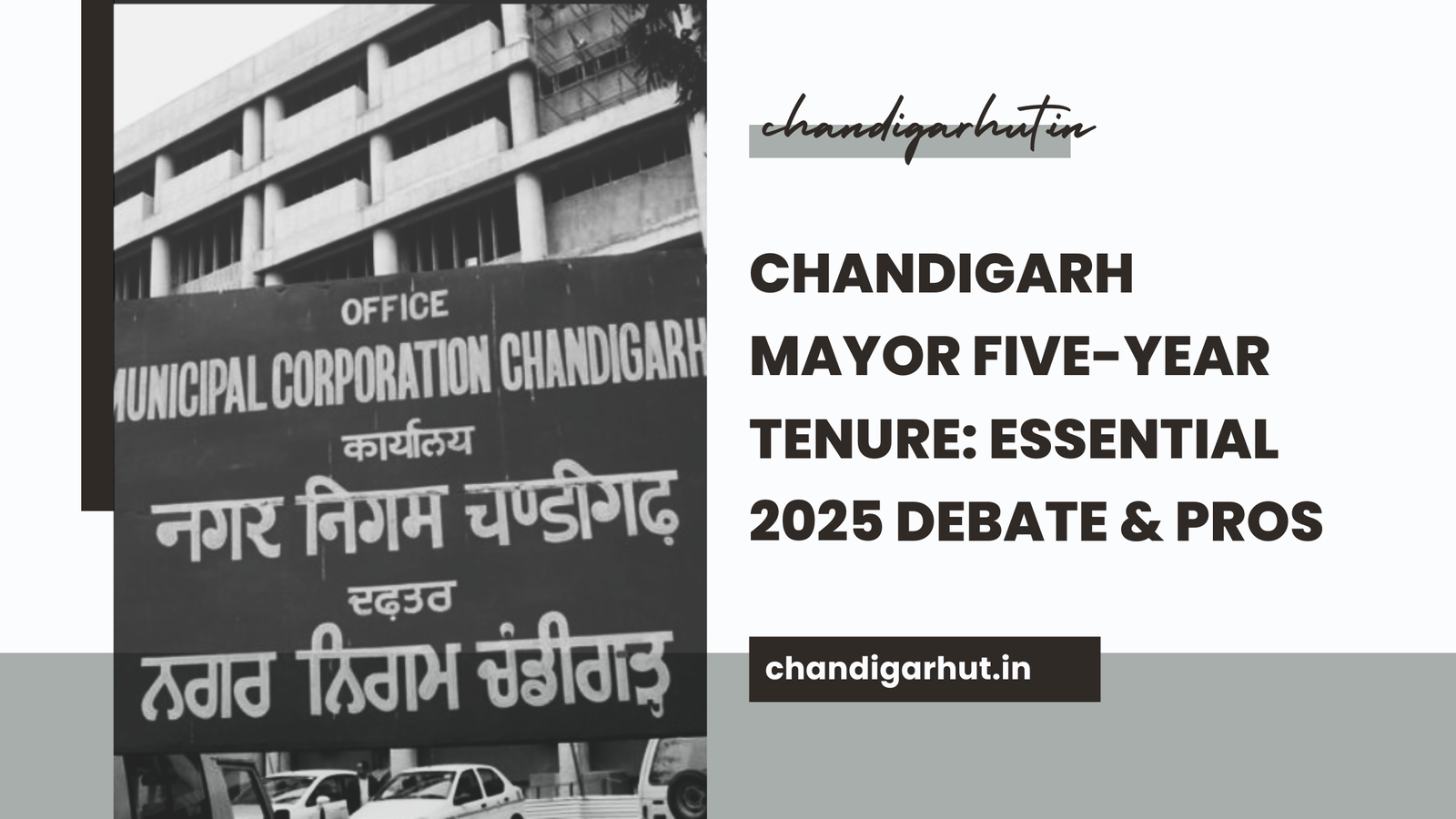Chandigarh Mayor five-year tenure is at the center of a major governance debate in the union territory. The UT Administration is weighing a shift from the current one-year term to a five-year tenure, a reform that could reshape how municipal leadership drives city development. This article examines the origins, the policy currents, the Centre-UT dynamics, and the practical steps required to move from proposal to possible law.
Across Chandigarh, stakeholders including MPs, councillors, and citizens are weighing the potential benefits and challenges of a longer mayoral term. The proposal is not just a procedural tweak; it touches on budget cycles, urban planning, political accountability, and the pace of development in a city that has witnessed more than 30 mayors since the Municipal Corporation framework began in 1994. The debate has attracted attention from the Union Government, with Centre voices urging a careful examination of models in other cities and UTs before any final move.
Context and Rationale Behind the Five-Year Mayor Tenure Idea
At its core, the discussion around the Chandigarh Mayor five-year tenure is about ensuring continuity in development projects and enabling long-term planning. Proponents argue that a longer tenure would grant a mayor the time required to implement strategic initiatives, complete mid-term projects, and render visible changes in service delivery. The phrase Chandigarh Mayor five-year tenure is frequently used in political exchanges and policy notes as a shorthand for a more stable governance model.
The impetus for change is not unique to Chandigarh. A Cabinet Secretariat committee created in 2018 looked at the governance architecture of all UTs and recommended a five-year term for mayors, coupled with a model that protects against the concentration of power and ensures accountability. Supporters insist that a five-year term would reduce ad hoc decisions, encourage longer municipal planning horizons, and align mayoral tenure with financial and development cycles.
Historical Background: How Chandigarh Has Evolved
The current one-year tenure for the Chandigarh Mayor traces back to 1994 when the Punjab Municipal Corporation Law Extension to Chandigarh Act was enacted. Since then, the city has seen multiple mayors, with a rotating leadership that some observers describe as creating gaps between vision and execution. Critics say that the one-year frame leaves little opportunity to test ideas in the public realm or see through multi-year infrastructure programs. The discussion around a five-year tenure is, in many ways, a response to historical patterns and governance expectations in a growing city.
Individually, councillors, senior officials, and citizens have voiced a sense of urgency for reform. In 2018, a Cabinet Secretariat panel suggested empowering a Mayor in Council elected by the electorate for a five-year term. While the panel’s recommendations highlighted the potential for a stronger executive arm at the UT level, the administration at that time differed on certain aspects, including voting rights for nominated members of the Municipal Corporation House. The current debate revisits these questions with fresh political energy.
What a Five-Year Term Could Change in Chandigarh
The prospect of a five-year mayoral term would bring several practical implications. Below are key areas that reform advocates and critics alike scrutinize.
- Policy continuity: A longer tenure could translate into more coherent urban development strategies and smoother execution of master plans, particularly in housing, transport, and public spaces.
- Budget synchronization: With budget cycles aligned to multi-year horizons, the mayor could oversee programs from planning through implementation, reducing mid-course corrections caused by frequent leadership changes.
- Governance balance: A properly empowered Mayor in Council could be directly elected by the electorate for a five-year term, potentially strengthening democratic legitimacy while preserving checks and balances.
- Administrative stability: Continuity in leadership may reduce churn in administrative staff, contractors, and project procurement timelines, benefiting large-scale projects.
- Public confidence: Citizens could experience progress more tangibly, leading to higher trust in municipal institutions when results are visible over several years.
On the other hand, critics warn about concentration of power, reduced accountability if elections are infrequent, and the risk of entrenchment among long-serving mayors. The balance of these factors will depend on the precise constitutional and statutory framework that accompanies any change in tenure. The Chandigarh UT Administration has indicated that if a five-year tenure is accepted, a formal Bill would be required to amend the relevant act and institutional norms.
Legal Framework and Legislative Pathways
The legal route for extending the mayoral tenure involves amendments to the Punjab Municipal Corporation Law Extension to Chandigarh Act and allied municipal governance provisions. In practice, a Bill would have to be introduced in Parliament and receive assent before becoming law. The Centre has publicly indicated a willingness to review representations and comments from Chandigarh’s leadership, including representations from the city’s MP. These steps reflect a typical Ottawa-style process where UTs request modifications to central acts that govern their civic structures.
A critical component of the proposed framework is how the electorate would participate in a directly elected Mayor in Council. The idea would be that the mayor would be elected by all eligible voters for a five-year term, with a governance model that may involve a council or executive committee. This structure is designed to ensure both accountability to voters and the ability to pursue long-term urban transformations without the disruption of annual electoral cycles.
Voices from Chandigarh: Support and Skepticism
Support for extending the mayoral tenure is broad among several councillors and citizens who view a longer term as essential for sustained development. Jasbir Singh Bunty, Senior Deputy Mayor, has publicly argued that a five-year tenure would allow for the systematic implementation of city-building initiatives. The argument is echoed by MPs and city planners who contend that the current framework aborts many initiatives before they can fully mature.
Despite broad interest in reform, skepticism remains. Critics emphasize the need to safeguard democratic accountability and prevent potential abuses of extended authority. They point to the risk that an extended term could narrow political competition or slow the turnover that injects fresh ideas into municipal governance. The Centre’s response to these concerns is likely to hinge on transparent institutional safeguards, robust audit mechanisms, and clear sunset clauses if necessary.
Comparative and Comparative Perspectives: UTs and Other Models
Across India, several UTs have explored longer mayoral tenures as part of a broader municipal governance reform. A 2018 Cabinet Secretariat committee recommended five-year mayoral terms for all UTs, with a specific caveat about not extending voting rights to nominated members, to preserve accountability through elected representation. The Chandigarh administration has carefully weighed these findings against local conditions, including staffing, budgetary constraints, and the pace of urban change. Chandigarh Mayor five-year tenure discussions increasingly reference these comparative models to assess feasibility and best practices.
Other cities with long-tenure models report varying degrees of success, depending on the strength of political institutions, administrative capacity, and robust oversight. The key takeaway for Chandigarh is that any shift must be accompanied by a credible governance package: clear roles for the Mayor in Council, performance-based evaluation, and transparent procedural rules to maintain public trust.
Implementation Challenges and Risk Mitigation
Transitioning to a five-year mayoral tenure would present practical implementation challenges that must be addressed in advance. Among the most important are:
- Constitutional and statutory harmonization: Aligning the Punjab Municipal Corporation Law Extension to Chandigarh Act with Centre-level governance standards and ensuring compatibility with existing municipal codes.
- Election mechanics: Designing a fair and inclusive electoral process for a Mayor in Council, including eligibility criteria, voting procedures, and safeguards against manipulation.
- Oversight and accountability: Establishing independent oversight bodies, regular audits, and performance metrics to maintain accountability over a longer term.
- Public engagement: Keeping citizens informed and involved in governance to prevent disengagement that can accompany changes to long-term leadership structures.
Administrative officials in Chandigarh emphasize that if the Centre approves the five-year tenure concept, the next step would be drafting a Bill to amend the applicable Act. The Bill would spell out the composition of the Mayor in Council, the election mechanism, and the scope of the mayoral powers. This process would require consultation with state and central legislators, as well as commentary from the UT Administration and Deputy Commissioner’s office.
Centre-UT Dynamics: What the Road Ahead Looks Like
The Centre’s engagement with Chandigarh on this issue reflects a broader principle: federal governance in India involves a careful balance between local autonomy and central oversight. The representation by MP Manish Tewari, who has strongly advocated a five-year tenure and even proposed a private member’s Bill, underscores the public interest in reform. The Centre has requested the Administration to share its comments on these representations, which is a necessary step before any formal parliamentary action.
In Chandigarh, the debate now centers on pragmatism: can the UT’s unique constitutional status be harmonized with a proposed five-year mayoral term while preserving accountability and local autonomy? Stakeholders expect the Government of India to weigh the recommendations from the UT Administration and the private Bill proposals before deciding on the next legislative move.
Next Steps and What to Expect
Looking forward, several concrete steps will likely shape the trajectory of this reform:
- The UT Administration finalizes its internal assessment, including models from other cities and UTs, and consolidates its position for formal submission to the Centre.
- The Centre reviews representations from Chandigarh’s leadership, including inputs from MP Manish Tewari, and drafts a response outlining possible constitutional and legal avenues.
- If a consensus emerges, a Bill would be introduced in Parliament to amend the relevant Acts, followed by committee scrutiny and debates in both Houses.
- Upon parliamentary approval, the necessary constitutional and statutory amendments would be implemented, accompanied by transitional arrangements for elections and governance structures.
Public communication and transparent implementation plans will be critical to maintaining trust during the transition. The Chandigarh administration understands that any change to the mayoral tenure is not merely a procedural adjustment but a reform with long-term consequences for urban governance, service delivery, and civic participation.
Frequently Asked Questions
What is the current term length for the Chandigarh Mayor?
The present practical framework fixes the Mayor’s term at one year, a setup that has governed the city since the Municipal Corporation was formed in 1994.
Why is there a push for a five-year tenure?
Proponents argue that a five-year tenure offers policy continuity, alignment with multi-year development plans, and the ability to deliver on long-term urban projects more effectively.
What legal steps are required to implement this change?
A formal Bill would need to be introduced in Parliament to amend the Punjab Municipal Corporation Law Extension to Chandigarh Act and related statutes, followed by parliamentary passage and presidential assent.
What role does Centre-UT interaction play in this process?
The Centre reviews Chandigarh’s representations, comments from the UT Administration, and any private member’s Bill, before deciding on legislative action or further study.
Conclusion
The proposal to move to a Chandigarh Mayor five-year tenure represents a pivotal moment in the city’s governance journey. It is not just about extending a term; it is about redefining how long-term urban strategies are conceived, funded, and delivered to residents. The interplay between policy ambition, legal feasibility, and democratic accountability will determine whether Chandigarh can successfully implement a longer-tenure model. As the UT Administration compiles its inputs and the Centre evaluates representations, stakeholders should expect a thoughtful, transparent process that weighs both the benefits of continuity and the safeguards required to keep power in check. The question remains: can a five-year tenure unlock the city’s potential while preserving the civic checks that safeguard democratic governance? The coming months are likely to offer a clearer answer.}









